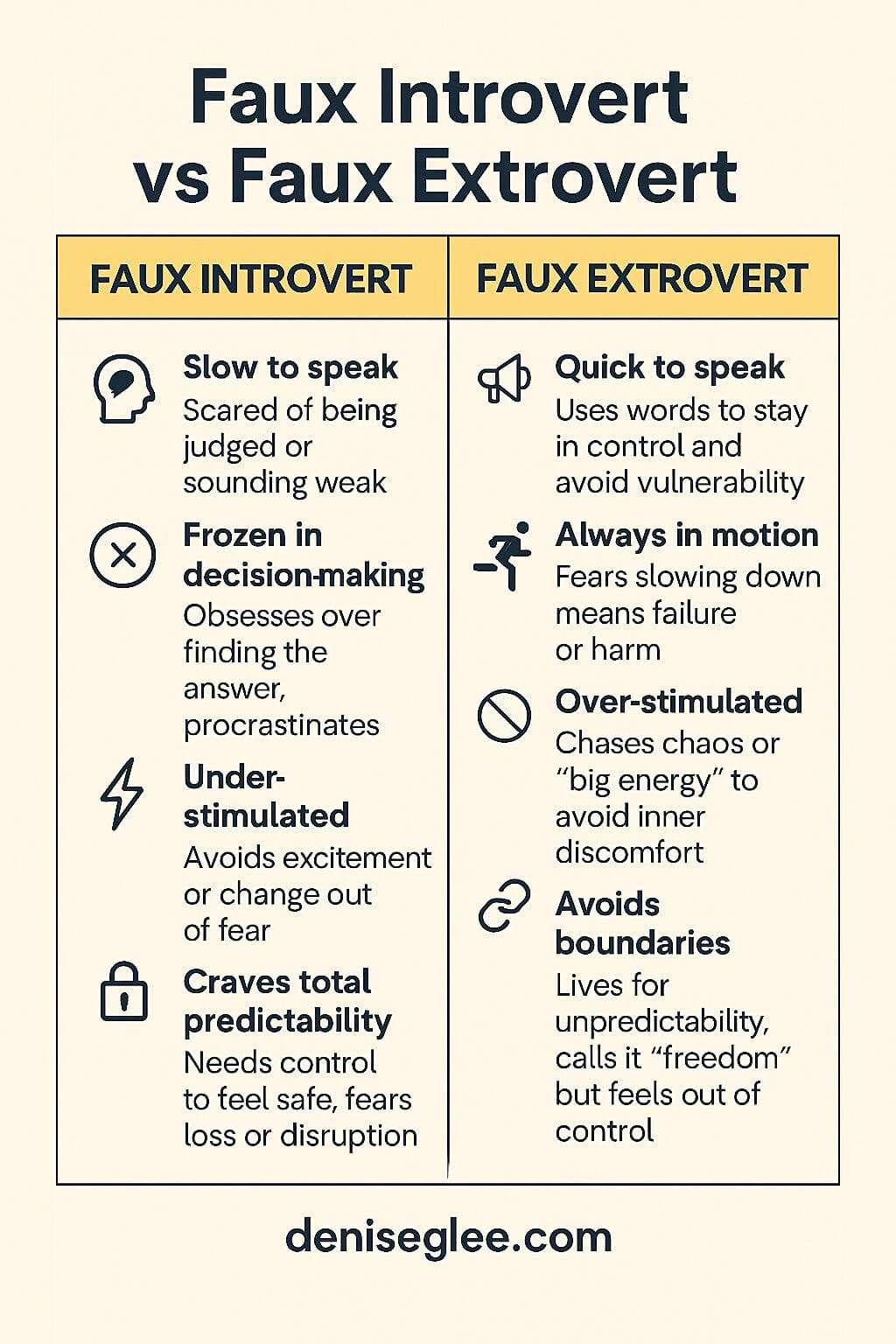
Your Personality Isn’t Broken—It’s a Trauma Script
- Updated: July 23, 2025
What if the version of you you’ve built — isn’t really you?
You might call yourself an introvert. Or an extrovert. Or some careful mix you’ve tested into a neat little box.
Maybe you’ve even written those labels down—tried to own them. Make them fit.
But what if it’s not personality at all?
What if it’s just survival — wearing a name tag?
I call it faux introversion (or faux extroversion). It’s what happens when you adapt so hard to stay safe that you forget it’s an act — and start calling it truth.
I see it all the time: smart, high-functioning people with big titles and neat lives — but they can’t shake the feeling that something’s off. That behind the job, the role, the mask — they’re numb. Flat. Half themselves.
If that’s you — good. You’re not here to scroll. You’re here because you’re ready to see it for what it is — and do something about it.
In this post, I’ll break down how trauma rewires identity, how to spot the subtle signs you’re performing instead of living — and what it really looks like to meet the real you under all that armor.
But first, let’s get one thing straight about introversion and extroversion — and what they don’t mean.
What This Will Make You Face
Where Did Introvert and Extrovert Even Come From?
Back in 1921, Carl Jung coined these terms to explain how people process the world:
Introverts look inward — thoughts, feelings, reflection.
Extroverts look outward — people, activity, energy.
Simple enough. Over time, it got reduced to a cliché: introverts recharge alone, extroverts feed off social time.
But here’s the part no one tells you: what you call “personality” might not be your nature — it might be your shield.

A Personality Built to Survive
If you grew up in chaos — constant judgment, criticism, rejection — your personality might not be a trait at all. It’s an adaptation. A role you perfected to stay safe.
This is called masking: reshaping how you show up to avoid punishment, fit in, or dodge conflict. Common for trauma survivors. Common for anyone who learned early that blending in was safer than standing out.
So maybe you’re “introverted” — but really, silence was safer than fights.
Or maybe you’re “extroverted” — but really, loudness hid insecurity you never got to heal.
In a minute, I’ll show you exactly how trauma wires these false patterns — and what it means for who you really are.
Why Your Personality Might Be a Survival Script
If you grew up in chaos — criticism, conflict, the sense that safety could vanish any second — your personality might not be your nature at all. It might be a survival script.
For some, survival meant shrinking: quiet, agreeable, invisible. A “freeze” or “fawn” response dressed up as introversion.
For others, survival meant performing: filling space, talking fast, cracking jokes. A masked extroversion to distract from the chaos inside.
These aren’t quirks. They’re shields. They help you move through the world — but they don’t always let you feel at home in it.

What happens when the danger’s gone — but the life script stays?
You end up stuck: at work, in love, in moments of quiet where you’re not sure who you really are anymore.
👉 If your personality feels more like a shield than a choice, this post breaks it wide open: Reclaim Masculinity After Emotional Castration
I see this all the time.
One client swore she was an introvert — “I just need space,” she’d say. But her story told the truth: two alcoholic parents, a home that flipped from fun to terrifying in a heartbeat. As a kid, she was expressive and playful — until she learned that being seen could mean punishment. So she shrank. She got quiet. She disappeared. Not because she was shy — but because that was safer.
I did the opposite.
I wore loudness like armor. The funny one. The life of the party. Always performing, always spinning the chaos so no one would see how lost I really felt. On the outside? Extrovert. On the inside? Wreckage.
If you’ve ever wondered why you feel off in your own skin — this is it.
That mask didn’t come out of nowhere. It came out of survival.
Next up: how faux introversion and faux extroversion show up — and what it takes to remember who you were before the performance.
How Trauma Builds a Flip-Flop Identity
For years, I told myself I was an extrovert.
I filled every room with noise — fast talk, fast moves, big energy. Especially around men — I needed to be seen, needed the validation. Loudness made me feel real.
But when I started healing, the volume dropped.
I didn’t want to talk so much.
I caught myself overthinking every word, every pause, every look. The same rooms that once felt easy suddenly felt suffocating.
Looking back, it’s obvious:
That swing between look at me and don’t see me — wasn’t personality.
It was protection.
My nervous system trying to keep me safe — first by performing, then by disappearing.
What I called “me” was really a flipbook of trauma responses — armor that looked like identity.

Are You Leading—or Just Repeating the Script?
Here’s the truth most high achievers hate to hear:
You can build a whole life — career, relationships, reputation — on patterns that were never you. Just well-polished shields.

So ask yourself:
Do you hold back in meetings — not because you’re “quiet,” but because you’ve learned speaking up means risk?
Do you dominate the room — not because you crave connection, but because silence feels like rejection?
These aren’t quirks.
They’re pain patterns, rehearsed so long they feel like personality.
So the real question isn’t, Am I an introvert or an extrovert?
It’s:
Who am I when I feel safe?
Who am I when I stop performing?
Next, I’ll show you exactly what faux introversion and faux extroversion look like in real life — and how to tell if you’re stuck in the script.
The Faux Introvert: Silence as Strategy
If you’re a faux introvert, you didn’t start that way.
You learned it. Practiced it. Perfected it — until even you believed it.
Maybe as a kid, speaking up earned you silence. Or worse — the glare, the yelling, the consequence that taught you your words were risky. So you locked them up. Safer that way.
Therapist Claudia Black calls this the placater: the kid who blends in so well nobody sees the storm underneath. They stay agreeable, polite, invisible. Because showing the truth? Costs too much.
Sound familiar?
That’s not shyness.
That’s strategy.

Faux introverts get good at shape-shifting — reading the room, staying small, mirroring moods so they don’t make waves. They keep the peace by erasing themselves.
And when something feels wrong? They retreat — first in the room, then in their own skin. Books, screens, neat routines. Quiet places with no questions, no shame. Predictable — unlike people.
Over time, that withdrawal starts to look like identity. “I’m just introverted.”
But here’s the truth:
Real introverts like solitude — they don’t need it to feel safe. They don’t panic at closeness. They don’t shut down when someone gets too close to their real.
If you’ve spent years convincing yourself alone is your comfort zone, ask yourself:
Is it comfort — or protection?
When you feel safe, you don’t vanish.
Your voice flows. Connection doesn’t drain you — it expands you.
Because your voice was never the problem.
The room was.
The Faux Extrovert: Noise as Distraction
I called myself an extrovert for years. Every test, every label — “life of the party,” “big energy,” “people person.” I believed it.
But looking back? That wasn’t personality.
It was survival on blast.
When my life was at its messiest — addiction, chaos, constant crisis — the last thing I wanted was silence. So I filled it: with noise, people, endless motion. Because stillness meant my truth might catch up.
Therapist Claudia Black calls this the Acting Out Child — the one who keeps the family distracted. If you’re the problem, nobody else has to look at the real wound.
That pattern doesn’t stop in childhood. Faux extroverts grow up brilliant at keeping the show going — so nobody sees what’s underneath. Your big energy becomes convenient: your visibility covers everyone else’s secrets.
So you build your identity on adrenaline. Fast talk. Big moves. New rooms, new crowds, new crises. Anything but quiet.
Because quiet feels like abandonment.
🧠 If you find yourself explaining away behaviors—yours or others’—this post might call you out: Stop Rationalizing Behavior

Three Signs You’re Not Really an Extrovert — You’re Just Escaping
1️⃣ Quick to Speak, Slow to Breathe
You fill every pause because silence feels dangerous. If you stop talking, you might be judged — or worse, you might hear your own thoughts.
2️⃣ Always Moving, Never Resting
Your calendar’s packed. Your brain runs hot. But the moment you slow down, dread hits — so you stay busy enough to outrun it.
3️⃣ Addicted to Stimulation, Afraid of Stillness
You call it passion or drive, but really it’s a way to dodge grief. Boredom isn’t boring — it’s a threat. It reminds you what you haven’t faced yet.

So, Is It Really You — Or Just the Mask?
If you’re honest, you know.
You overshare to stay liked.
You overcommit so you’re never forgotten.
You crave chaos because it keeps you safe from the quiet.
That’s not extroversion.
That’s armor.
And here’s the truth:
You don’t need the buzz when you feel safe.
You don’t need the noise to prove you’re alive.
You get to choose: when to show up big — and when to sit in the stillness without fear it’ll swallow you whole.
Spot Yourself — or Keep Pretending
Before you scroll past, check the chart below. If you see your patterns here, you’re not “introverted” or “extroverted” — you’re performing safety. Name it. Then decide if you’re ready to drop it.
💛 Real intimacy starts with showing your real self. If you’re learning how to connect from truth, not performance, read this: Emotional Intimacy Is a Learnable Skill

Ready to Drop the Mask—or Finally See It?
If you see yourself here — good. It means your performance is cracking. That’s the point.
Most people read this and nod along — then do nothing. They keep the mask, keep the exhaustion, keep pretending it’s personality instead of pain.
Not you. Not if you’re serious.
If you’re ready to stop performing safe and start showing up real:
Work with me 1:1 — We’ll break your survival scripts wide open and rebuild from something true.
Take the Life Script Questionnaire — Get clear on the invisible patterns running your show.
Listen in — Start with Episode #391: Pseudo Introvert or Extrovert? and hear how deep this goes.
I don’t do surface fixes. I don’t babysit illusions. If you’re done calling your wounds a personality trait — you know where to find me.
The mask is heavy. You can keep wearing it — or you can put it down.
Your choice.





